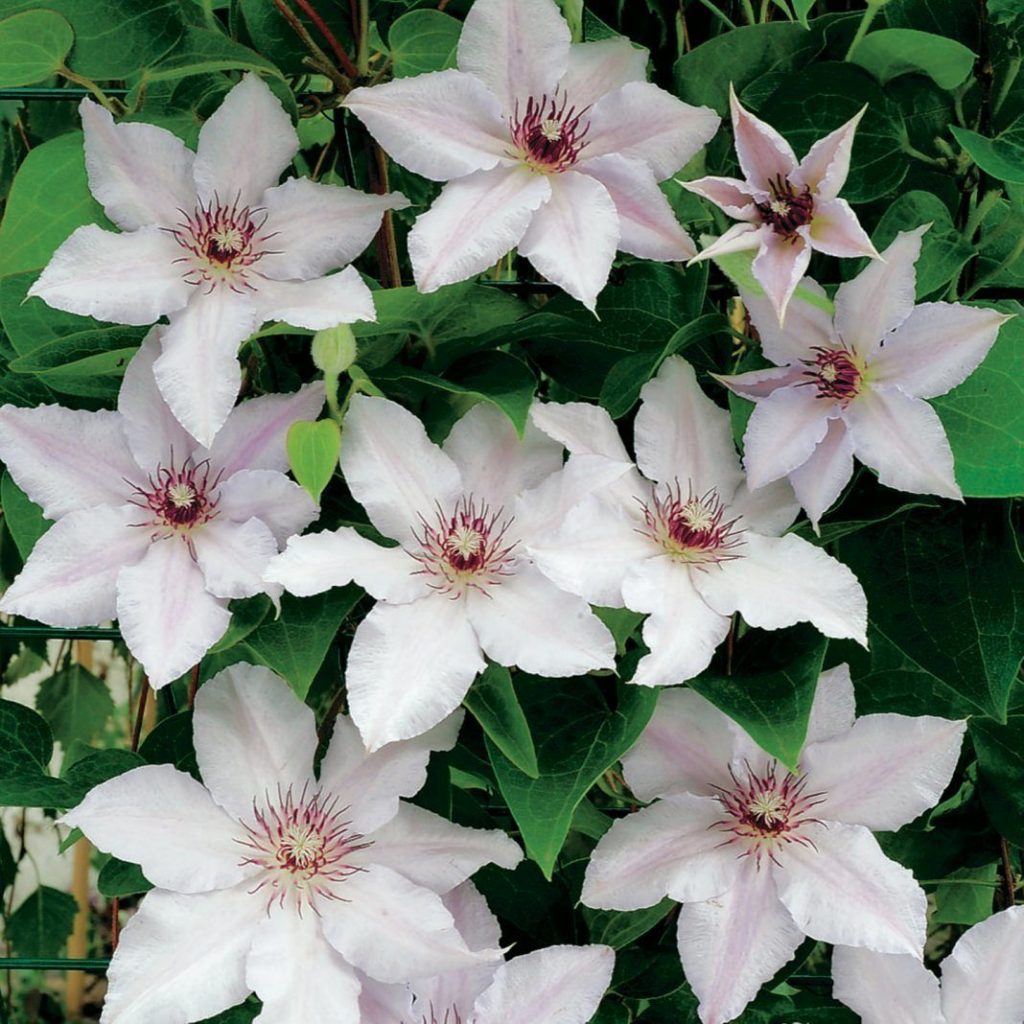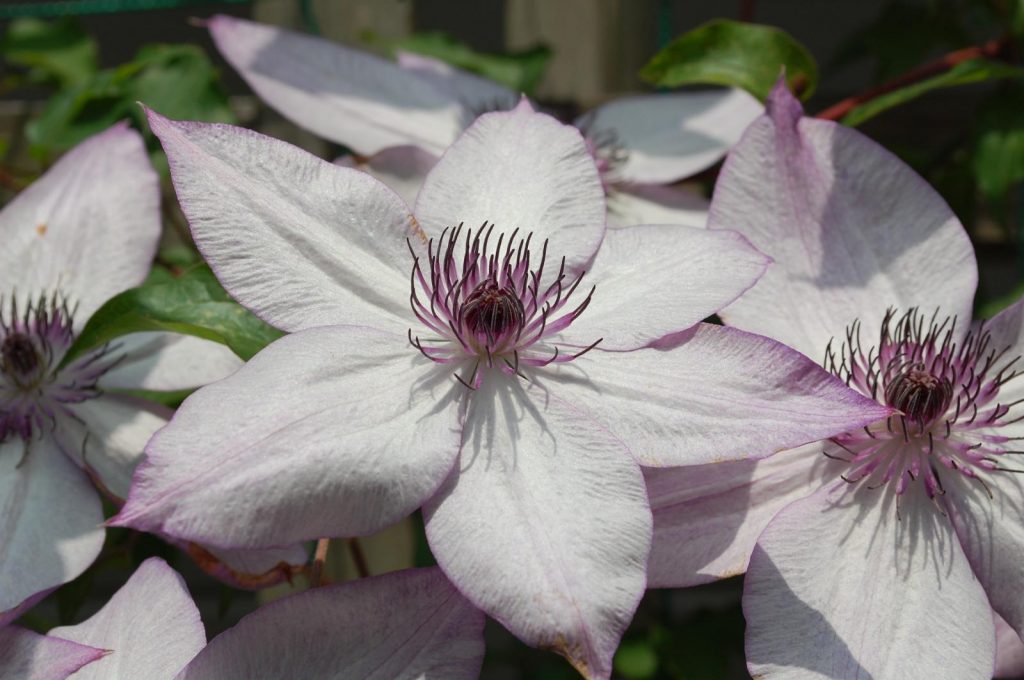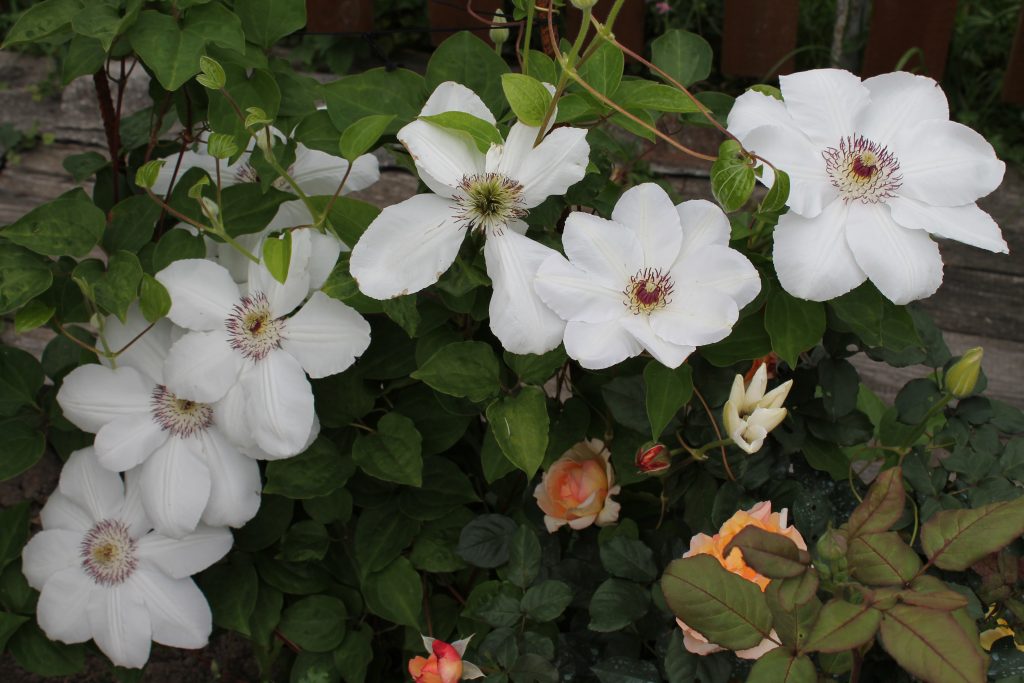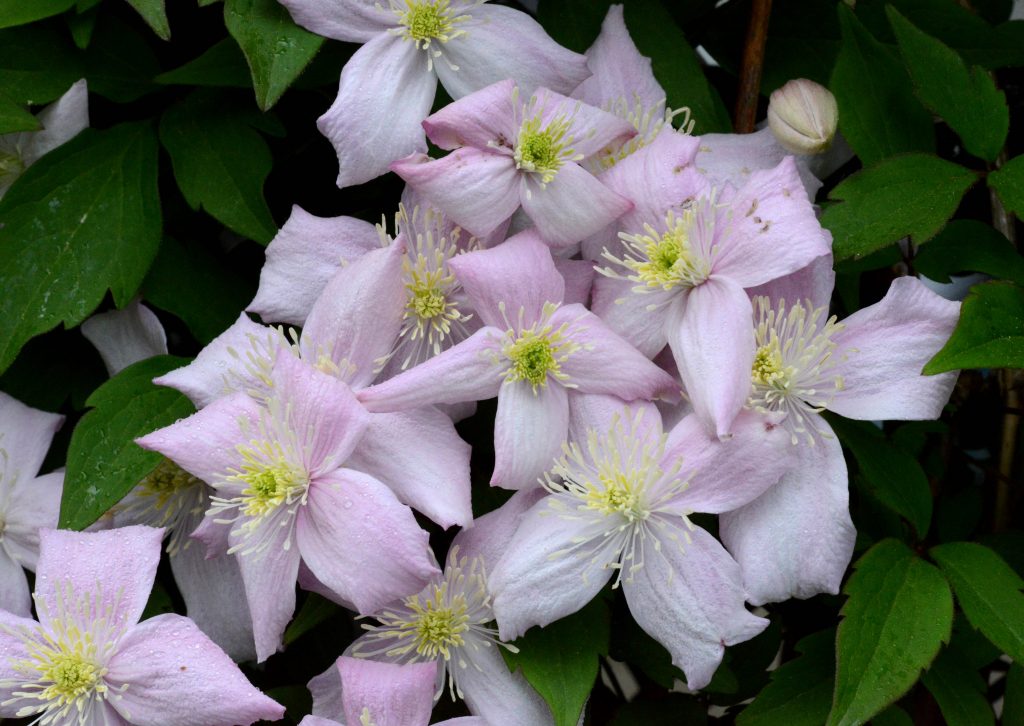Clematis Queen Jadwiga - planting and care
Modern Polish breeder Szczepan Marchinsky has created an amazingly beautiful large-flowered clematis Queen Jadwiga. This hybrid immediately conquered millions of gardeners around the world. The variety not only strikes with decorativeness, but is also considered one of the most unpretentious among all lianas. It is grown even in Siberia and the Far East.
- Description of the variety
- Landing features
- Seat selection
- Preparation of planting material
- Landing technology
- Care
- Watering
- Top dressing
- Mulching and loosening
- Trimming and shaping
- Garter to support
- Preparing for winter
- Reproduction
- Cuttings
- Rooting layers
- Dividing the bush
- Diseases and pests
- Use in landscape design
- Testimonials
- Useful videos

Clematis queen yadwig
Description of the variety
This clematis is a deciduous perennial plant with abundant and long flowering.
The bush is medium-sized, the shoots reach 2-2.5 m, they are flexible, and grow stiff as they grow back. Leaves are oval, trifoliate, lanceolate, arranged in pairs, dark green. The petioles are long and tenacious, helping the plant to braid the support and hold on to it.
The flowers are large, white, up to 17 cm in diameter. Consists of 8 petals with a velvety surface and wavy edges. A noticeable straight groove runs along the center of each sepal. The stamens are bright lilac, the core is yellow. The root system is fibrous, highly branched, it grows half a meter to the sides of the main trunk.
Long bloom - from May to the first frost. Vegetation takes place in two passes:
- The first wave is in May-June (flowers bloom on the stems of the last year);
- The second - in August-October (buds appear on young shoots).
The hybrid is resistant to cold weather, it is successfully grown even in the Far East, where in winter the temperature often drops to -40 ° C.
Landing features
The Queen Yadviga hybrid is characterized by an underdeveloped root system in the first years of life.

Clematis queen yadwiga photo description and reviews
It depends on the condition of the roots in which season to plant a young plant.
In southern latitudes, clematis is usually placed in the ground in the fall, but in the case of this hybrid, you need to be careful. If the roots are poorly developed, then it is better to place it for growing in a greenhouse or keep it at home in a flowerpot for another year, and only then plant a garden.
In the middle lane or in the north of the country, it is better to plant and transplant clematis in the spring. Then, over the summer, the bush will have time to strengthen and start growing.
Attention! The main condition for planting is to cut off all the buds for the first three years if they are tied.
The plant should devote all its strength to the formation of a healthy and strong root system (a problem spot in a hybrid). The variety differs from the others in its early flowering, but it is better not to let it bloom until the 4th year of life.
Seat selection
Clematis loves good lighting and fertile soil. The place should not be damp and shady - the roots will rot, the plant may die. If the groundwater flows close to the surface, it is better not to plant a bush in this place, or at least make a good multilayer drainage.
The Queen Jadwiga hybrid is picky about the composition and acidity of the soil. It is desirable that it be neutral.You can try to reduce the acidity by adding dolomite flour or ash, but this does not always save the day.
Preparation of planting material
A seedling ready for planting should consist of 2-3 healthy shoots and at least 3 roots longer than 10 cm.
The root system should be given special attention. If the roots are dark, swollen, with growths or bloom, it is better not to plant such a plant in open ground, but to hold it at home in a flowerpot, giving time to strengthen.
If the seedling was bought in an online store and was delivered by mail, then its roots will most likely be overdried. It must be kept in water with the addition of a root formation enhancer. When planting, you do not need to shake off the ground, so as not to damage the already weak thin roots.
Landing technology
A hole for the bushes is prepared in advance. Its size depends on the age and size of the bush itself, but usually it is 40x40 cm.The depth is at least 40 cm.
They make full-fledged drainage: with stones, shards, expanded clay and sand. In such a planting pit, moisture will be well absorbed and will not stagnate at the roots.
The nutrient soil for the hybrid is mixed in the following proportions:
- 3 kg of sand;
- 150 g of ash;
- 5 kg of compost;
- 200 g of mineral fertilizer "Nitrofoska";
- 50 g superphosphate.
The seedling is placed in a hole on a layer of soil and sprinkled on top, slightly lifting and shaking. So the earth is evenly distributed between the roots. The bush is watered so that the soil is a donkey, and again poured to the desired level. The horse's neck of the plant should be 10-15 cm hidden by the ground. Otherwise, the hybrid will not survive.
Care
The Queen Jadwiga hybrid is undemanding to care for, but there are certain rules. Subject to their fulfillment, clematis will delight with flowering for a long time - from May to October - almost without a break.

Clematis queen yadwig description photo
Watering
It is necessary to water the plant often, in summer every 2-3 days (less often in rainy weather). Young bushes, in which the root system is just being formed, especially need regular watering. Without a sufficient amount of moisture, small peripheral roots will not form, clematis will wither and ache.
Important! For watering, it is better to prepare water in advance by standing it in a bucket or collecting rainwater. The tap water is too hard and the weak roots of clematis will not absorb it properly.
Top dressing
In the first year after planting, you do not need to fertilize the plant. He will have enough nutrients obtained from the soil.
Top dressing begins from the second year, when the hybrid successfully survives the winter in the open field.
The diagram is presented in the table:
| Season | Food |
| Early spring | Nitrogen substances are introduced under the bush for the growth of greenery - shoots and leaves. Of the mineral complexes are suitable: UAN (urea-ammonium mixture), any (potassium, ammonium, calcium) nitrate, ammophoska, urea. |
| May, bud formation period | phosphorus-potassium fertilizers are needed. These are superphosphate (15-20 g per 1 m²), potassium chloride or sulphate (30-40 g m²), as well as potassium sulfate (20-25 g per m²). A good mineral complex is nitroammofoska (45-60 g m²). |
| Autumn (top dressing will help prepare for winter and transfer it without unpleasant consequences) | Manure or bird droppings are introduced. The main thing is that it is well rotted, preferably 2-3 years old, mixed with hay or straw. There are many nutrients in organics that the plant needs to replenish after flowering. |
| Summer | Tea leaves or coffee grounds, potato broth or herbal infusions are periodically poured under the bushes. Of course, the liquid must be cooled beforehand. Nettle-based sourdough is also good in terms of feeding - it is simply put in a barrel, poured with water and left for a month. Then the bush is poured with water, and the grass is laid out in a circle near the trunk as mulch. |
Mulching and loosening
The soil under the clematis must be loosened periodically. It is imperative to do this after watering or if the ground is beaten by heavy rain.The main thing to remember is that the roots of all clematis are superficial, so when loosening them it is easy to damage them. Better to just pierce the ground with a sharp stick to draw air to the roots.

Clematis queen yadwig reviews
Mulch the ground under the bush so that moisture does not evaporate too quickly, and also to protect the roots from the heat. In winter, mulch serves as additional insulation. Sawdust, humus, grass or hay are suitable for these purposes. Also, crushed pieces of wood are laid around the trunk of the clematis, similar to the substrate for orchids.
It is easy to replace mulching by planting annual grasses under a clematis bush. Marigolds and calendula are especially good for this. They not only protect the roots of flowering creepers, but also repel harmful insects. After dying off, these herbs are converted into fertilizer with many micronutrients.
Trimming and shaping
The Queen Jadviga variety belongs to the II pruning group. This means that flowers are formed on both last year's and young shoots.
Lush flowering can only be achieved with proper pruning. It should be started in summer, after the first wave of flowering.
First, part of last year's shoots that have faded are removed. They are shortened by 2/3 or eliminated completely.
In autumn, after the last flowering, young shoots are also cut off, leaving 1.5 meters. The bush needs shaping during the year. Dried vines, as well as deformed and damaged branches, must be removed in a timely manner.
Garter to support
The bush firmly clings to the support with flexible leaf stalks, but in places where there is often strong wind, it is better to tie it up. In several places, the vines are tied to a support at a height of 1-1.5 meters. In this case, they will not be blown off by the wind, and the bush will not be damaged.
Preparing for winter
In the fall, after the last pruning, the plant is removed from the support, twisted into a ring and laid on a pine spruce. Then covered with a non-woven fabric.
Someone prefers to fall asleep clematis laid on spruce branches with dry garden foliage, and put sponbond and film on top. This option is more suitable for northern regions.
The main thing is not to be late in the spring with the removal of the film and leaves, so that the bushes do not rot.
Reproduction
The procedure is carried out in three ways: cuttings, dividing the bush, layering.
Sometimes an adult bush, over 8-10 years old, gives root processes, they are planted separately - this is also a way of reproduction.
Cuttings
Shoots for cutting cuttings are best taken young, grown after winter. They are harvested in April-May, each cutting must contain at least 3 live buds.
Cuttings with leaves are also fine, but it is better to start the procedure when the buds are swollen.
Cuttings can take root in water or soil, but the latter is preferred. The twigs are dipped in Kornevin for 2-3 hours, then immediately placed in a special substrate. Its composition is approximately as follows:
- Humus (50%)
- Peat (30%)
- Perlite (10%)
- Vermiculite (5%)
- Ash (5%)
After planting, the cutting is watered with heteroauxin, diluted with water, and placed in a warm, bright place. The rooting temperature should be + 26-27 ° C. The first roots begin to grow back after 1-2 weeks, but the growing young leaves will tell about the final rooting.
Rooting layers
This is the easiest way to breed any lianas. One or more branches are bent to the ground and buried in. The main thing is not to forget to water the place dug into the ground. Rooting under good conditions will take place within 2-3 months. You can speed up this process by making an incision on the vine, holding it in Kornevin for 2-3 hours, and then digging it into the ground.

Clematis queen yadwig photos
It is better to separate the layers from the mother bush after wintering. Rooted vines are still too weak to survive the winter apart from the main bush. With the arrival of spring, when the plant grows, you can safely separate the layers and plant them in a permanent place.With this method of propagation, all varietal properties of the hybrid are preserved.
Dividing the bush
An adult bush is dug up, shaken off the ground and the roots are divided with a sharp knife so that each part has a separate growth point. Places of cut must be treated with a solution of potassium permanganate, sprinkled with activated carbon. You can dip the roots in Fitosporin solution so that they are not attacked by the fungus.
Separate parts of the bush are planted in pre-prepared holes. At the same time, varietal properties will be preserved, in contrast to the seed propagation method. The smallest bushes can be kept in the house or in the greenhouse for the first year. The old mother bush is returned to its place, after adding previously humus and nutrient earth.
Diseases and pests
The worst enemy of clematis is soil fungus. It causes several diseases at once - fusarium, rust, spotting. Mushrooms in the soil are different, but universal fungicides will help to cope with them:
- Fundazol
- Epin
- Phytocide
- Copper sulfate
- Speed
It is better to prevent the development of the disease than to cure it later. The fungus infects clematis with waterlogging and lack of light. These vines cannot be grown in the shade on moist soil. If the planting site is selected correctly, and the irrigation regime is not violated, then the bush will remain healthy.
Of the pests, the bush is affected by nematodes, caterpillars, aphids, larvae of May beetles and slugs. There are attacks by other insects, but rarely.
Nematodes are the most dangerous. They settle in the roots, so it is difficult to notice them in time. With a strong defeat, the bush will have to be completely destroyed.
Caterpillars and aphids can be easily dealt with with insecticides: Biotlin, Lepidocid, Dendrobacillin. May beetle larvae do not like it if there is a lot of nitrogen in the soil. Therefore, regular feeding with nitrogen complexes will at the same time be a means of pest control. Slugs are most efficiently harvested by hand.
Use in landscape design
The variety Queen Jadviga is perfect for decorating arbors, as it grows strongly, with abundant and long flowering. By planting bushes along the walls, you can advantageously decorate them, like poles, lanterns, arches. Tenacious clematis vines are able to braid any support, but it is better to tie them up additionally for fidelity.

Clematis Jadwiga
Plants look better in joint compositions from different species. If you pick them right, you can achieve continuous flowering in the garden. Also, clematis is combined with climbing roses - they look amazing. Some types of ornamental grapes and climbing honeysuckle are also used in landscaping.
Testimonials
Queen Jadwiga is an amazing variety that has received a huge number of positive reviews. Most gardeners like its winter hardiness. In southern latitudes, it hibernates without any problems even without shelter. The ease of reproduction also attracts lovers of this species of liana.
The hybrid grows very quickly, braiding, for example, a gazebo in just a few weeks. The lush bloom makes it the best decoration for buildings, arches and other garden objects.
Clematis is characterized by high winter hardiness and immunity to diseases. Without requiring complex care, it is able to bloom for almost the entire warm season (from May to October). It is successfully used in landscape design, combining with other climbing plants. The popularity of the variety is growing every year, confirming its many advantages.

